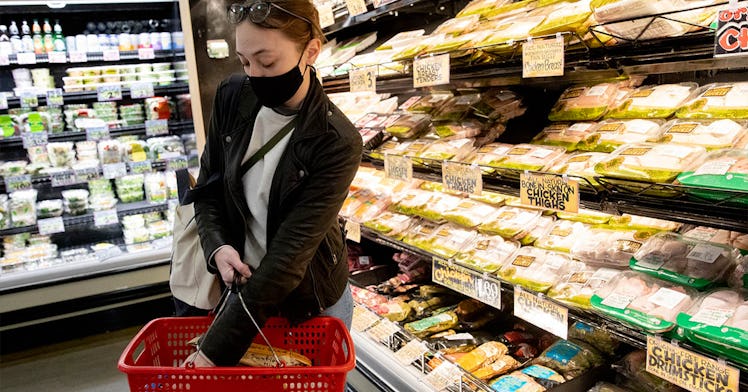Biden Administration Announces Historic Increase in Food Stamp Benefits
Average benefits will rise more than 25 percent from prepandemic levels. But is it enough?

The Biden administration’s Department of Agriculture announced the largest permanent increase to SNAP benefits (née Food Stamps) in the 60-year history of the program. Average benefits will increase by more than 25 percent from pre-pandemic levels, and all 42 million program participants—including 20 million children, or a quarter of American kids—will have more money for food even after pandemic-motivated increases to food benefits expire.
This historic increase has its origins in a surprising place: the 2018 Farm Bill, passed by a Republican Congress. It ordered a review of the assumptions determining how much the program paid out. Former Rep. Mike Conaway, the lead sponsor of that bill, told the New York Times that the law was written “assuming the precedent of cost-neutrality would be followed.”
But Conaway and company didn’t explicitly write cost-neutrality into their bill, which gave the Biden administration an opening. It opted to increase the benefits provided by the program—not decrease or leave them unchanged as the GOP that fundamentally disagrees with food stamps would doubtlessly prefer.
Here’s what families need to know about these latest changes.
How were SNAP benefits calculated?
The rationale for increasing benefits is a data-driven review of the Thrifty Food Plan, the “cost of groceries needed to provide a healthy, budget-conscious diet for a family of four.” The TFP was first issued in 1975 based on costs set in 1962. The foods included in the TFP have been updated over the years, ostensibly to reflect changing eating habits and dietary recommendations. But aside from inflation adjustments, its value has never increased.
The old TFP ignored factors like convenience (quicker-to-prepare foods are obviously preferred by those working long hours) and geographic differences in prices. It was also designed for families with kids 12 and under, ignoring the reality that teenagers eat a lot more, as any parent with kids in high school can attest.
It also relied solely on the spending habits of poor people rather than including other budget-conscious spenders. That means it incorporates the sacrifices the poor had to make into the formula that determines what they’ll receive in benefits instead of basing that amount on what they should receive (i.e. what is needed to afford adequate, healthy groceries.
That flawed process meant that the maximum aid available through SNAP could not pay for a modest diet in 96 percent of American counties, according to a study by the Urban Institute.
How is the Biden administration changing those calculations?
The USDA sought to correct these deficiencies to ensure that the benefit aligned with what SNAP participants needed. The new and improved TFP reflects how four factors—”current food prices, what Americans typically eat, dietary guidance, and the nutrients in food items Americans typically eat”—have changed in the past 45 years.
The new TFP relies on a broader price index that considers consumers outside of the poor. It based calculations on a seven percent increase calories, based on weight gains and exercise recommendations. It also incorporated more convenience foods, reflecting the reality of eating habits, and seafood, reflecting updated dietary recommendations.
“It was a scientific, analytical process,” Stacy Dean, a senior USDA official, told the Times. “It wasn’t about approving a benefit increase,” as Republican opponents of the increase have been quick to assert.
How much will benefits increase? And when?
A family of four will receive an additional $34 per week on average, from $159 to $193. Benefits will increase starting on October 1, the beginning of the federal government’s new fiscal year.
What will increased benefits mean for program participants?
Having more money to spend on groceries will help recipients afford healthier foods, which tend to cost more than their heavily processed counterparts. Sixty-one percent of SNAP participants reported the cost of healthy foods as a barrier to eating better.
For instance, fresh vegetables are more expensive than canned but have much less sodium, overconsumption of which can exacerbated conditions like diabetes and hypertension.
But beyond affording healthier foods, the increase in SNAP benefits will help families afford food period. More than three-quarters of households spend all of their benefits in the first half of the month, meaning families are left to scrape by during the second half of the month until their next disbursement. The consequences of this are negative and numerous; the Times cited everything from increased (and likely expensive) hospital visits to more school suspensions to lower SAT scores.
Of course, if families are spending their entire benefit in half a month then the logical conclusion would be to double the benefit so that it lasts the entire month. That’s something of an oversimplification, but the facts do suggest that the increase—while impressive relative to the history of the program and certainly welcome—will lessen childhood hunger and poverty instead of eradicating it. That means if the United States is to live up to the principle that no one should go hungry in a country this wealthy, this increase is a necessary, but not adequate step in the right direction.